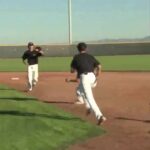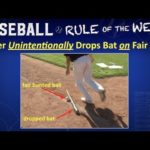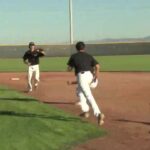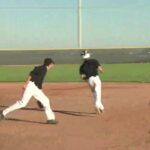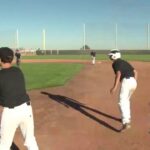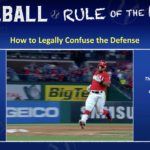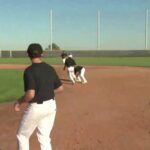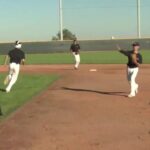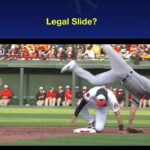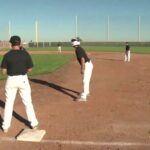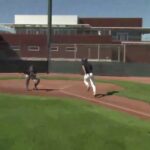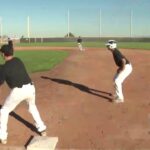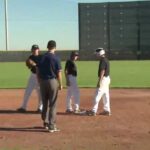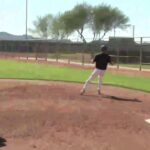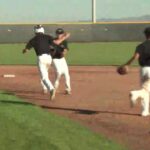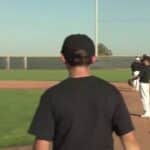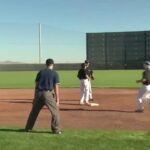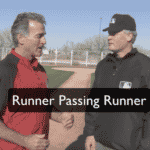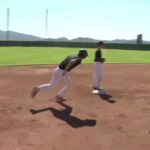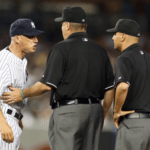7.08 Runner Out
Any runner is out when –
(a) (1) running more than three feet away from his/ her baseline to avoid being tagged, unless such action is to avoid interference with a fielder fielding a batted ball. A runner’s baseline is established when the tag attempt occurs and is a straight line from the runner to the base to which he/ she is attempting to reach; or
(2) after touching first base, the runner leaves the baseline, obviously abandoning all effort to touch the next base; or
(3) the runner does not slide or attempt to get around a fielder who has the ball and is waiting to make the tag; or
A.R.— There is no “must slide rule.”
(4) Little League (Major) and below only: the runner slides head first while advancing.
(b) intentionally interferes with a thrown ball; or hinders a fielder attempting to make a play on a batted ball (NOTE: A runner who is adjudged to have hindered a fielder who is attempting to make a play on a batted ball is out whether it was intentional or not);
(c) that runner is tagged, when the ball is alive, while off a base;
EXCEPTION: A batter-runner cannot be tagged out after overrunning or over sliding first base if said batter-runner returns immediately to the base.
A.R. 1— This includes a batter-runner who overruns first after being awarded a base on balls.
A.R. 2— If the impact of a runner breaks a base loose from its position, no play can be made on that runner at that base if the runner had reached the base safely.
A.R. 3— If a base is dislodged from its position during a play, any following runner on the same play shall be considered as touching or occupying the base if, in the umpire’s judgment, that runner touches or occupies the dislodged bag, or the point marked by the original location of the dislodged bag.
(d) failing to retouch the base after a fair or foul ball is legally caught before that runner, or the base, is tagged by a fielder. The runner shall not be called out for failure to retouch the base after the first following pitch, or any play or attempted play. This is an appeal play.
NOTE: Base runners can legally retouch their base once a fair ball is touched in flight and advance at their own risk if a fair or foul ball is caught.
(e) failing to reach the next base before a fielder tags said runner or the base after that runner has been forced to advance by reason of the batter becoming a runner. However, if a following runner is retired on a force play, the force is removed and the runner must be tagged to be put out. The force is removed as soon as the runner touches the base to which that runner is forced to advance, and if oversliding or overrunning the base, the runner must be tagged to be put out. However, if the forced runner, after touching the next base, retreats for any reason towards the base last occupied, the force play is reinstated and the runner can again be put out if the defense tags the base to which the runner is forced;
(f) touched by a fair ball in fair territory before the ball has touched or passed an infielder. The ball is dead and no runner may score, no runners may advance, except runners forced to advance;
EXCEPTION: If a runner is touching a base when touched by an Infield Fly, that runner is not out, although the batter is out.
NOTE 1: If a runner is touched by an Infield Fly when not touching a base, both runner and batter are out.
NOTE 2: If two runners are touched by the same fair ball, only the first one is out because the ball is instantly dead.
(g) attempting to score on a play in which the batter interferes with the play at home base before two are out. With two out, the interference puts the batter out and no score counts;
(h) passes a preceding runner before such runner is out;
(i) after acquiring legal possession of a base, the runner runs the bases in reverse order for the purpose of confusing the defense or making a travesty of the game. The umpire shall immediately call “Time” and declare the runner out;
(j) failing to return at once to first base after overrunning or oversliding that base. If attempting to run to second the runner is out when tagged. If, after overrunning or oversliding first base the runner starts toward the dugout, or toward a position, and fails to return to first base at once, that runner is out, on appeal, when said runner or the base is tagged;
(k) in running or sliding for home base, the runner fails to touch home base and makes no attempt to return to the base, when a fielder holds the ball in hand, while touching home base, and appeals to the umpire for the decision.
(NOTE: This rule applies only where the runner is on the way to the bench and a fielder would be required to chase the runner to tag him/ her. It does not apply to the ordinary play where the runner misses the plate and then immediately makes an effort to touch the plate before being tagged. In that case, the runner must be tagged.)

